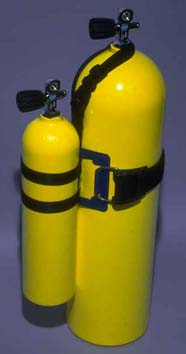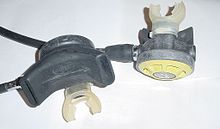



Scuba gas planning is the aspect of dive planning and of gas management which deals with the calculation or estimation of the amounts and mixtures of gases to be used for a planned dive. It may assume that the dive profile, including decompression, is known, but the process may be iterative, involving changes to the dive profile as a consequence of the gas requirement calculation, or changes to the gas mixtures chosen. Use of calculated reserves based on planned dive profile and estimated gas consumption rates rather than an arbitrary pressure is sometimes referred to as rock bottom gas management. The purpose of gas planning is to ensure that for all reasonably foreseeable contingencies, the divers of a team have sufficient breathing gas to safely return to a place where more breathing gas is available. In almost all cases this will be the surface.[1]
Gas planning includes the following aspects:[2]: Sect.3
- Choice of breathing gases
- Choice of scuba configuration
- Estimation of gas required for the planned dive, including bottom gas, travel gas, and decompression gases, as appropriate to the profile.[1]
- Estimation of gas quantities for reasonably foreseeable contingencies. Under stress it is likely that a diver will increase breathing rate and decrease swimming speed. Both of these lead to a higher gas consumption during an emergency exit or ascent.[1]
- Choice of cylinders to carry the required gases. Each cylinder volume and working pressure must be sufficient to contain the required quantity of gas.
- Calculation of the pressures for each of the gases in each of the cylinders to provide the required quantities.
- Specifying the critical pressures of relevant gas mixtures for appropriate stages (waypoints) of the planned dive profile (gas matching).
Gas planning is one of the stages of scuba gas management. The other stages include:[2]: Sect.3 [1]
- Knowledge of personal and team members' gas consumption rates under varying conditions
- basic consumption at the surface for variations in workload
- variation in consumption due to depth variation
- variation in consumption due to dive conditions and personal physical and mental condition
- Monitoring the contents of the cylinders during a dive
- Awareness of the critical pressures and using them to manage the dive
- Efficient use of the available gas during the planned dive and during an emergency
- Limiting the risk of equipment malfunctions that could cause a loss of breathing gas
The term "rock bottom gas planning" is used for the method of gas planning based on a planned dive profile where a reasonably accurate estimate of the depths, times, and level of activity is available, so the calculations for gas mixtures and the appropriate quantities of each mixture are known well enough to make fairly rigorous calculations useful. Simpler, easier, and fairly arbitrary rules of thumb are commonly used for dives which do not require long decompression stops. These methods are often adequate for low risk dives, but relying on them for more complex dive plans can put divers at significantly greater risk if they are unaware of the limitations of each method and apply them inappropriately.
© MMXXIII Rich X Search. We shall prevail. All rights reserved. Rich X Search
